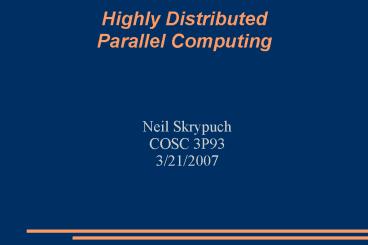Highly Distributed Parallel Computing - PowerPoint PPT Presentation
1 / 41
Title:
Highly Distributed Parallel Computing
Description:
a network of computers all working towards a similar goal ... Painlessly Scalable. smooth curve upwards for both cost and performance. Simpler to Program ... – PowerPoint PPT presentation
Number of Views:17
Avg rating:3.0/5.0
Title: Highly Distributed Parallel Computing
1
Highly DistributedParallel Computing
- Neil Skrypuch
- COSC 3P93
- 3/21/2007
2
Overview
- a network of computers all working towards a
similar goal - network consists of many nodes, few servers
- nodes perform computing and send results to a
server - servers distribute jobs
- node machines do not communicate with eachother
3
Pros
4
Relatively Simple
- don't need to worry about special
interconnections - don't need to worry about cluster booting
5
Non-Homogeneous Network
- can work across different computer architectures,
OSes, etc - computers can be of varying speeds
- doesn't require the fastest or most expensive
computers - computers can be distributed anywhere in the world
6
Infrastructure
- infrastructure for HDPC already exists almost
everywhere - anyone with a network of computers is already
ready for HDPC - lots of programs already exist that take
advantage of HDPC
7
Expansion
- expansion is painless
- there are no special constraints on the shape
of the network - not fast enough yet? keep adding more computers
until it is
8
Resilience to Failure
- it doesn't matter if one or more nodes die
- only the reliability of the central server(s)
matter
9
Cons
10
Suitability
- not all problems are suited to HDPC
- highly communication bound problems are a poor
fit for HDPC
11
Server Dependence
- central server dependence is a double edged sword
- if the central server becomes unavailable,
everything grinds to a halt
12
Network (In)security
- how to verify if a client should be allowed to
join the network? - protecting data sent over the network
- verifying integrity and authenticity of data sent
over the network
13
Network (Un)reliability
- nodes temporarily losing connectivity may make
them temporarily useless
14
Dealing With the Issues
15
Server Dependence
- the central server need not be a single server
- server itself may be clustered
- countless ways to cluster servers
16
Clustering With a Database
- allow nodes to talk directly to the database
- cluster the database over multiple servers
- multi-master replication
- single master replication
- lots more...
17
Server Hierarchy
- multiple tiers of servers may also be used
- could be considered recursive HDPC
- very similar to the tree architecture of
supercomputers
18
Lost Nodes
- define a maximum amount of time to wait for a
node's response - use redundancy
- assume some nodes will always be lost
- send duplicate jobs to multiple nodes
simultaneously
19
Network (In)security
- not as big of an issue as one might think
- encryption and public key infrastructures
mitigate most confidentiality and authenticity
concerns - redundancy is useful for both reliability and
security
20
Work Buffering
- taking larger portions of work at a time
- temporary connectivity issues pose less of a
problem this way - a node can continue working without talking to a
central server for longer
21
Where is HDPC Useful?
22
Combinatorics
- search
- enumeration
- generation
23
Cryptography
- brute force cipher cracking
- gives a glimpse of the future, in terms of what
the average person will be able to crack
24
Artificial Intelligence
- genetic algorithms
- genetic programming
- alpha-beta search
25
Graphics
- ray tracing
- animation
- fractal generation and calculation
26
Simulation
- weather and climate modeling
- particle physics
27
Guidelines for Suitability
- most problems involving a large search tree are
well suited to HDPC - anything that can be broken down into smaller,
self-contained, chunks is a good candidate for
HDPC
28
How Well Does HDPC Work?
29
Folding_at_Home
- 200,000 non-dedicated nodes
- 240 TFLOPS
- approximately 40 central servers, unknown speeds
30
SETI_at_Home
- 200,000 non-dedicated nodes
- 288 TFLOPS
- 10 central servers, all relatively modest
31
Blue Gene/L
- currently the fastest supercomputer
- not HDPC
- 65,536 dedicated nodes
- 280 TFLOPS
- cost about 100,000,000 US
32
HDPC Works Well
- typical speedup is close to linear
- cost is substantially less than a comparable
supercomputer - nodes can also be general purpose computers
33
Why Does HDPC Work Well?
34
Infrastructure Reuse
- in general, new hardware investments are not
necessary - creating new infrastructure is expensive and time
consuming - it's easy to justify using things you already
have for additional purposes - there are tons of idle CPUs at any given time,
why not use them?
35
Low Barrier to Entry
- anyone with a couple of networked computers can
start experimenting
36
Painlessly Scalable
- smooth curve upwards for both cost and performance
37
Simpler to Program
- doesn't require as much thinking in parallel in
comparison to other approaches - thinking in parallel is hard and fundamentally
different than thinking serially - pushes the heavy lifting onto the database
instead of the application programmer
38
Commodity Hardware is Fast
- a typical desktop machine today is more powerful
than a supercomputer from 15 years ago - and costs orders of magnitude less
- and outputs much less heat
- and takes up much less space
- and consumes much less power
39
The Future
- supercomputers will become faster
- HDPC will become even faster than supercomputers
- as both number of computers and speed increases
- both supercomputers and HDPC will fill their own
separate niche
40
Questions and Discussion
41
References
- http//fah-web.stanford.edu/cgi-bin/main.py?qtype
osstats - http//www.boincstats.com/stats/project_graph.php?
prsah - http//www.boincstats.com/stats/project_graph.php?
prbo - http//www.itjungle.com/tlb/tlb033004-story04.html
- http//setiathome.berkeley.edu/sah_status.html
- http//fah-web.stanford.edu/serverstat.html
- http//top500.org/list/2006/11/100































